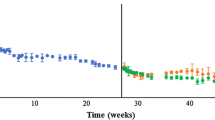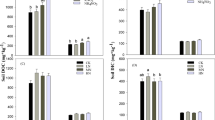Abstract
Fertilization of nutrient-depleted and degraded forest soils may be required to sustain utilization of forests. In some European countries, the application of composts may now be an alternative to the application of inorganic fertilizers because commercial compost production has increased and compost quality has been improved. There is, however, concern that compost amendments may cause increased leaching of nitrogen, trace metals and toxic organic compounds to groundwater. The objective of this study was to assess the risk of ammonium (NH4 +), nitrate (NO3 −) and dissolved organic nitrogen (DON) leaching following a single compost application to silty and sandy soils in mature beech (Fagus sylvatica L.), pine (Pinus silvestris L.) and spruce (Picea abies Karst.) forests at Solling and Unterlüß in Lower Saxony, Germany. Mature compost from separately collected organic household waste was applied to the soil surface at a rate of 6.3 kg m−2 in the summer of 1997 and changes in NH4 +, NO3 − and DON concentrations in throughfall and soil water at 10 and 100 cm soil depths were determined for 32 months. The spruce forests had the highest N inputs by throughfall water and the highest N outputs in both the control and compost plots compared with the pine and beech forests. Overall, the differences in total N outputs at 100 cm soil depth between the control and compost plots ranged between 0.3 and 11.2 g N m−2 for the entire 32-month period. The major leaching of these amounts occurred during the first 17 months after compost amendments, but there was no significant difference in total N outputs (−0.2 to 1.8 g N m−2) between the control and compost plots during the remaining 15 months. Most of the mineral soils acted as a significant sink for NO3 − and DON as shown by a reduction of their outputs from 10 to 100 cm depth. Based on these results, we conclude that application of mature compost with high inorganic N contents could diminish the groundwater quality in the first months after the amendments. A partial, moderate application of mature compost with low inorganic N content to nutrient depleted forest soils can minimize the risk of NO3 − leaching.
Similar content being viewed by others
References
Aber J, McDowell W, Nadelhoffer K, Magill A, Berntson G, Kamakea M, McNulty S, Currie W, Rustad L and Fernandez I 1998 Nitrogen saturation in temperate forest ecosystems — Hypotheses revisited. Bioscience 48, 921–934.
Agren G I, Boasatta E 1988 Nitrogen saturation of terrestrial ecosystems. Environ. Pollut. 54, 185–197.
Ammar S B 1996 Impacts of separation on compost quality. In The Science of Composting. Ed. M De Bertoldi, P Sequi, B Lemmes and T Papi. pp. 1071–1073. Chapman & Hall, London.
Bauhus J and Meiwes K J 1994 Potential use of plant residue wastes in forests of northwestern Germany. For. Ecol. Manage. 66, 87–106.
Bresson L M, Koch C, Le Bissonnais Y, Barriuso and V Lecomte 2001 Soil surface structure stabilization by municipal waste compost application. Soil Sci. Soc. Am. J. 65, 104–1811.
Borken W, Muhs A, and Beese F 2002 Changes in microbial and soil properties following compost treatment of degraded temperate forest soils. Soil Biol. Biochem. 34, 403–412.
Chen Y, Inbar Y and Hadar Y 1992 Composted residues reduce peat and pesticide use. Biocycle 6, 48–51.
Chodak M, Borken W, Ludwig B and Beese F 2001 Effect of temperature on the mineralisation of C and N of fresh and mature compost in sandy material. J. Plant Nutr. Soil Sci. 164, 289–294.
Cox D, Bezdicek D and Fauci M 2001 Effects of compost, coal ash, and straw amendments on restoring the quality of eroded Palouse soil. Biol. Fertil. Soils 33, 365–372.
Dail B D, Davidson E A and Chorover J 2001 Rapid abiotic transformation of nitrate in an acid forest soil. Biogeochemistry 54, 131–146.
Davidson E A, Keller M, Erickson H E, Verchot L V and Veldkamp E 2000 Testing a conceptual Model of soil emissions of nitrous and nitric oxides. Bioscience 50, 667–680.
Dise N B and Wright R F 1995 Nitrogen leaching from European forests in relation to nitrogen deposition. For. Ecol. Manage. 71, 153–161.
FAO 1998 World reference base for soil resources. In World Soil Resources Reports, 84, FAO, ISRIC and ISSS, Rome, Italy.
Feddes R A, Kowalik P, Neuman S P and Bresler P 1977 Finite difference and finite element simulation of field water uptake by plants. Hydrol. Sci. 21, 81–98.
Guerrero C, Gomez I, Mataix Solera J, Moral R, Mataix Beneyto J and Hernandez M T 2000 Effect of solid waste compost on microbiological and physical properties of a burnt forest soil in field experiments. Biol. Fert. Soils 32, 410–414.
Hallett R A, Bowden W B and Smith C T 1999 Nitrogen dynamics in forest soils after municipal sludge additions. Water, Air, Soil Pollut. 112, 259–278.
Hüser R 1977 Untersuchungen zur Klärschlammverwertung im Wald. Forstw. Cbl. 96, 238–245.
Johnson D W, Cheng W and Burke I C 2000 Biotic and abiotic nitrogen retention in a variety of forest soils. Soil Sci. Soc. Am. J. 64, 1503–1514.
König N and Fortmann H 1996 Probenvorbreitungs-, Untersuchungs-und Elementbestimmungsmethoden des Umweltanalytik-Labors der Niedersächsischen Forstlichen Versuchsanstalt und des Zentrallabors des Forschungszentrums Waldökosysteme. Ber. Forschungszentr. Waldökosysteme, Reihe B, Bd. 46–47.
Ludwig B, Deutschmann G and Xu Y J 2000 Acidification of solid and solution phases at greater depths (> 150 cm) at Solling spruce site. Water Air Soil Pollut. 120, 89–105.
Meiwes K J, Merino A and Beese F O 1998 Chemical composition of throughfall, soil water, leaves and leaf litter in a beech forest receiving long term application of ammonium sulphate. Plant Soil 201, 217–230.
Monteith J J and Unsworth J L 1990 Principles of environmental physics. Arnold, Paris.
Mualem Y 1976 A new model for predicting the hydraulic conductivity of unsaturated porous media. Water Resource Res. 12, 513–522.
Oren R, Ellsworth D S, Johnsen K H, Phillips N, Ewers B E, Maier C, Schäfer KVR McCarthy H, Hendrey G, McNulty SG and Katul GG 2001 Soil fertility limits carbon sequestration by forest ecosystems in a CO2-enriched atmosphere. Nature 411, 469–472.
Pinamonti F and Zorzi G 1996 Experiences of compost use in agriculture and in land reclamation projects. In The Science of Composting. Eds. M de Bertoldi, P Sequi, B Lemmes and T Papi. pp. 517–527. Chapman & Hall, London.
Sahrawat K L and Keeney D R 1986 Nitrous oxide emission from soils. Adv. Soil Sci. 4, 103–148.
SAS Institute 1996 SAS/STAT User's Guide, Release 6.03. SAS Institute Cary, NC.
Schwarz O 1977 Über die Auswirkungen von Müllklärschlammkomposten (MKK) auf Forstkulturen in der Oberrheinebene. Forstw. Cbl. 96, 246–253.
Swartzendruber D 1969 The flow of water in unsaturated soils. In Flow through porous media. Ed RJM De Wiest. pp. 215–292. Academic Press, New York, USA.
Ulrich B 1994 Nutrient and acid-base budget of central European forest ecosystems. In Effects of acid rain on forest processes. Eds. DL Godbold and A Hüttermann. pp. 1–50. Wiley-Liss, New York, USA.
van Genuchten M T 1980 A closed-form equation for predicting the hydraulic conductivity of unsaturated soils. Soil Sci. Am. J. 44, 892–898.
Vangronsveld J, Colpaert J V and Van Tichelen K K 1996 Reclamation of a bare industrial area contaminated by non-ferrous metals: Physico-chemical and biological evaluation of the durability of soil treatment and revegetation. Environ. Pollut. 94, 131–140.
Van Miegroet H, Cole DW, and Foster NW 1992 Nitrogen distribution and cycling. In Atmospheric deposition and forest nutrient cycling. Eds. D L Johnson and S E Lindberg. pp. 178–199. Springer, New York, USA.
Vestgarden L S, Abrahamsen G and Stuanes A O 2001 Soil solution response to nitrogen and magnesium application in a Scots pine forest. Soil Sci. Soc. Am. J. 65, 1812–1823.
Wong M T F, Nortcliff S and Swift R S 1998 Method for determining the acid ameliorating capacity of plant residue compost, urban waste compost, farmyard manure, and peat applied to tropical soils. Comm. Soil Sci. Plant Anal. 29, 2927–2937.
Zech W, Guggenberger G and Schulten H R 1994 Budgets and chemistry of dissolved organic carbon in forest soils: effects of anthropogenic soil acidification. Sci. Total Environ. 152, 49–62.
Author information
Authors and Affiliations
Rights and permissions
About this article
Cite this article
Borken, W., Xu, Y. & Beese, F. Ammonium, nitrate and dissolved organic nitrogen in seepage water as affected by compost amendment to European beech, Norway spruce, and Scots pine forests. Plant and Soil 258, 121–134 (2004). https://doi.org/10.1023/B:PLSO.0000016543.36970.29
Issue Date:
DOI: https://doi.org/10.1023/B:PLSO.0000016543.36970.29




